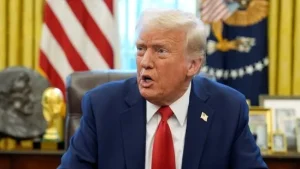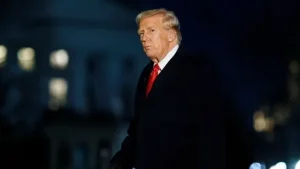New Delhi: In an aggressive move to reshape international trade, U.S. President Donald Trump has revived his campaign for reciprocal tariffs, a strategy designed to counterbalance trade disparities by imposing equal import duties on goods from countries that charge higher tariffs on American exports. Among the nations most affected, India stands to lose an estimated $3.1 billion in exports to the U.S., according to an analysis by CareEdge Ratings.
This announcement comes at a time when global trade is undergoing major transformations, with protectionist policies gaining traction in several major economies. The move aligns with Trump’s broader economic agenda of ensuring that the U.S. is no longer taken advantage of in trade agreements—a sentiment he has echoed since his first term in office. However, this decision could lead to increased costs for American businesses and consumers, potential disruptions in supply chains, and strained diplomatic relations with key trade partners, including India.
 For India, which has a strong economic relationship with the U.S., these new tariffs pose both immediate and long-term challenges. Sectors like steel, textiles, pharmaceuticals, automobile components, and engineering goods could face higher duties, impacting export competitiveness and overall trade volumes. The concern is not just about lost revenue but also about the potential shifts in global supply chains that could impact Indian manufacturers and exporters.
For India, which has a strong economic relationship with the U.S., these new tariffs pose both immediate and long-term challenges. Sectors like steel, textiles, pharmaceuticals, automobile components, and engineering goods could face higher duties, impacting export competitiveness and overall trade volumes. The concern is not just about lost revenue but also about the potential shifts in global supply chains that could impact Indian manufacturers and exporters.
However, amidst these concerns, some silver linings could emerge. The tariff war may push India to strengthen alternative trade alliances, increase domestic manufacturing, and enhance its attractiveness as a preferred global investment hub. The question now is: Can India effectively navigate this new trade landscape, or will it struggle under the weight of rising tariffs?
This article provides a comprehensive analysis of the implications of Trump’s reciprocal tariffs, the industries most affected, how the Indian government and businesses are responding, and what lies ahead for global trade dynamics.
Also Read: India Imposes 100% Tariffs on US Goods Ahead of ‘Liberation Day: “A Bold Move for Economic Fairness”
What Are Reciprocal Tariffs?
Reciprocal tariffs are a trade policy mechanism designed to match the import duties that other countries impose on U.S. goods. This approach ensures that if a country imposes high tariffs on American exports, the U.S. will retaliate with equivalent tariffs on imports from that country.
U.S. President Donald Trump has been a vocal advocate of reciprocal tariffs, arguing that the U.S. has long been at a disadvantage in global trade. His stance is based on the idea that countries like China, India, and the European Union impose higher tariffs on American products while enjoying lower duties on their own exports to the U.S. This policy also aims to encourage fair trade practices by pressuring trading partners to lower their tariffs on American goods, promoting more balanced trade relationships. However, reciprocal tariffs significantly impact global trade dynamics. While they may lead to trade negotiations, they also risk escalating into tariff wars, disrupting supply chains, and increasing costs for businesses and consumers worldwide.
How Will It Work?
For instance, if India imposes a 25% tariff on American steel, the U.S. will now impose the same 25% duty on steel imports from India. This approach is meant to eliminate trade imbalances and encourage countries to negotiate fairer trade agreements.
While this policy may seem beneficial to domestic U.S. industries, it disrupts established trade relationships and poses significant challenges for exporters in affected countries.
One of the biggest casualties of Trump’s reciprocal tariff policy is India, which could lose approximately $3.1 billion in exports to the U.S. This figure may represent just 0.1% of India’s GDP, but it is a major concern for key industries that heavily rely on U.S. demand.
India’s Potential $3.1 Billion Export Loss: What Sectors Are at Risk?
A recent CareEdge Ratings report indicates that several critical Indian industries will be significantly impacted by Trump’s reciprocal tariffs. These industries include steel, textiles, automotive components, and pharmaceuticals companies, all of which depend on the U.S. as a major export market.
1. Steel Industry and Aluminum Industry
-
The U.S. has already imposed tariffs on steel and aluminum imports from several countries, including India. Under Trump’s previous administration, Indian steel exports to the U.S. faced a 25% tariff while aluminum exports faced a 10% tariff.
-
In 2023, India exported approximately $1.2 billion worth of steel to the U.S.. With higher tariffs, Indian steel producers may find it difficult to compete with local American manufacturers or with other suppliers from countries with preferential trade agreements, such as Canada and Mexico.
-
As a result, demand for Indian steel could shrink, forcing Indian producers to divert exports to alternative markets or reduce production.
2. Textiles and Apparel
-
India’s textile and apparel industry is one of the biggest contributors to the country’s economy, with the U.S. being a top market for Indian textile exports. Indian companies export large volumes of:
✔ Cotton garments
✔ Home furnishings
✔ Synthetic textiles
✔ Readymade apparel -
With new tariffs, Indian textile manufacturers may lose their competitive edge, as U.S. importers look toward Vietnam, Bangladesh, and other low-cost production hubs that have more favorable trade agreements with the U.S.
-
India’s textile industry relies on government subsidies and tax benefits, but additional U.S. tariffs could make Indian goods more expensive, leading to a potential decline in exports.
3. Automotive Components and Engineering Goods
-
The Indian automobile sector, particularly auto components, has seen significant growth in exports to the U.S.
-
The U.S. is one of the largest consumers of Indian-manufactured spare parts, including engine components, transmission systems, and brake assemblies.
-
A higher tariff on auto components could lead to American manufacturers shifting their supply chains to Japan, South Korea, or Europe, where suppliers might be able to offer competitive pricing with lower duties.
-
This shift could impact India’s automobile manufacturing sector, particularly small and medium-sized enterprises (SMEs) that depend on U.S. contracts.
4. Pharmaceuticals and Chemicals
-
India is one of the world’s largest suppliers of generic medicines, accounting for over 40% of generic drugs consumed in the U.S..
-
Indian pharmaceutical companies, such as Sun Pharma, Dr. Reddy’s, and Cipla, heavily depend on the U.S. market for their revenues.
-
However, Trump’s policy aims to promote domestic production of pharmaceuticals, which could lead to reduced dependence on Indian suppliers.
-
If reciprocal tariffs are imposed, Indian pharma firms may face a decline in sales, while U.S. drug manufacturers could gain a competitive advantage.
Other Industries at Risk
Apart from the major sectors listed above, other Indian industries could also suffer setbacks due to Trump’s reciprocal tariff policy:
-
Information Technology (IT) Services – While not directly related to tariffs, stricter trade policies could affect Indian IT firms like TCS, Infosys, and Wipro, which provide services to U.S. clients.
-
Jewelry and Gems – India is a major exporter of diamonds and gold jewelry to the U.S., and new tariffs could reduce demand for these luxury goods.
-
Agricultural Exports – India exports spices, rice, and processed foods to the U.S., and increased tariffs could affect competitiveness in the American market.
Can India Counter the Impact of Reciprocal Tariffs?
While the immediate impact of reciprocal tariffs is concerning, India has several strategies to mitigate the losses and adapt to the changing trade landscape.
-
Bilateral Trade Negotiations – The Indian government can negotiate preferential trade agreements (PTAs) with the U.S. to exempt certain industries from higher tariffs.
-
Diversification of Export Markets – India can expand trade partnerships with Europe, ASEAN, and the Middle East to reduce dependency on U.S. markets.
-
Boosting Domestic Manufacturing – The Make in India initiative could be leveraged to increase self-reliance in key sectors.
-
Attracting Foreign Investments – India can position itself as a global investment hub, offering alternatives to China for supply chain diversification.
Mixed Market Response: Resilience Amid Uncertainty
Despite concerns over the $3.1 billion export loss, India’s financial markets have demonstrated resilience in the face of Trump’s tariff announcement. While industries dependent on U.S. exports are reassessing their strategies, broader economic indicators remain stable.
-
Stock Market Performance: The BSE Sensex and NSE Nifty have seen minor fluctuations but have largely stabilized, indicating that investors are not panicking over the immediate economic impact.
-
Indian Rupee Stability: Contrary to expectations of currency depreciation, the Indian Rupee has strengthened by 2% against the U.S. dollar in recent weeks, signaling confidence in India’s overall economic position.
-
Investor Sentiment: Market analysts at BofA Global Research and J.P. Morgan Private Bank predict that India’s economy will weather the impact in the medium term, given its diversified trade partnerships and strong domestic demand.
While export-heavy sectors such as steel, textiles, and pharmaceuticals are expected to face short-term challenges, the Indian government and businesses are taking proactive steps to mitigate risks.
Potential Silver Linings: Could India Benefit from the Tariff Policy?
Although reciprocal tariffs pose immediate risks, several economic experts argue that India can turn this into a strategic advantage by focusing on trade diversification, domestic manufacturing, and foreign investments.
1. Diversifying Trade Partnerships
-
Reducing Reliance on the U.S. Market: The Indian government is working to diversify export destinations and strengthen bilateral trade relationships with countries in Europe, the Middle East, and the Indo-Pacific region.
-
India-EU Free Trade Agreement (FTA): The ongoing India-EU FTA negotiations could result in lower trade barriers, opening new markets for Indian goods. This agreement could offset losses from U.S. tariffs by increasing exports to European nations.
-
Strengthening Ties with UAE, Japan, and Australia: India is expanding economic ties with these key trading partners, ensuring smoother export channels for industries affected by U.S. tariffs.
2. Boost to Domestic Manufacturing
-
Government-Backed Initiatives: Policies such as “Make in India” and the Production-Linked Incentive (PLI) scheme aim to support Indian industries by providing financial incentives, tax benefits, and infrastructure support.
-
Localized Supply Chains: With higher U.S. tariffs discouraging exports, companies may shift focus to the domestic market, leading to higher consumption and production within India.
-
Growth of the MSME Sector: Small and medium-sized enterprises (SMEs) in manufacturing, textiles, and engineering could benefit from increased domestic demand as companies realign their strategies.
3. Attracting Foreign Investment
-
Global Companies Seeking Alternatives to China: As U.S.-China trade tensions continue, multinational corporations (MNCs) are looking for new production bases outside China. India, with its growing workforce and improving infrastructure, is an attractive alternative.
-
Expansion of Manufacturing Hubs: Companies such as Apple, Tesla, and Samsung are already expanding operations in India, anticipating long-term growth and reduced geopolitical risks.
-
Government Support for Foreign Investors: The Indian government is actively offering policy incentives, tax breaks, and land reforms to attract foreign direct investment (FDI) in manufacturing and technology sectors.
How Is the Indian Government Responding?
The Indian Ministry of Commerce and Industry is taking a multi-pronged approach to minimize the economic impact of reciprocal tariffs. Key actions include:
✔ Diplomatic Negotiations: India is expected to initiate discussions with the U.S. Trade Representative (USTR) to seek tariff relief or negotiate exemptions for critical industries, such as pharmaceuticals, textiles, and steel.
✔ Expansion of Trade Networks: The government is actively engaging with ASEAN, African, and Middle Eastern nations to diversify trade routes and reduce reliance on the U.S.
✔ Tax Incentives and Subsidies: To support industries affected by the tariffs, the Indian government is exploring financial aid, tax exemptions, and policy support for exporters.
✔ Promotion of Local Innovation: Encouraging Indian companies to innovate, modernize production, and explore alternative markets through R&D investment and government grants.
Government’s Confidence in Economic Resilience
Pravakar Sahoo, Programme Director at NITI Aayog, emphasized that India’s economy is robust enough to handle these challenges. He stated that strategic planning, trade policy adjustments, and market diversification could turn the situation into an advantage for India in the long run.
Global Implications: Will a Trade War Emerge?


1. Potential U.S.-China Trade War Escalation
-
The U.S. and China have been locked in a trade war for years, and Trump’s re-election have intensified tensions.
-
China might retaliate with counter-tariffs on U.S. goods, further disrupting global supply chains.
-
India could position itself as a neutral trade partner, benefiting from companies relocating operations out of China.
2. Increased Tensions with the European Union
-
The EU has criticized Trump’s tariff policies, calling them unilateral and protectionist.
-
If trade tensions between the U.S. and EU escalate, India is planning to strengthen its position as an alternative supplier for European markets.
3. Rising Costs for American Consumers
-
Higher import tariffs could lead to increased prices for American consumers, as companies pass the costs onto buyers.
-
Industries reliant on global supply chains (such as automobiles and electronics) could face higher production costs, leading to inflationary pressures in the U.S.
4. Uncertainty in Global Supply Chains
-
Countries affected by U.S. tariffs may retaliate by implementing their own trade restrictions, leading to a ripple effect on global trade flows.
-
Industries that depend on raw material imports could see higher costs and potential production delays.
- Investment Hesitation: Businesses may delay expansion plans or new investments due to uncertainty in trade policies, leading to slower economic growth and reduced job creation.
Conclusion: A Defining Moment in U.S.-India Trade Relations


However, while the immediate consequences may seem severe, India’s long-term response will determine whether these tariffs become a setback or a catalyst for strategic economic growth. Several factors will play a crucial role in shaping the future:
-
Diplomatic and Trade Negotiations: India’s ability to engage in diplomatic discussions with the U.S. Trade Representative (USTR) and negotiate tariff relief or preferential trade agreements will be key in mitigating the negative impact.
-
Diversification of Export Markets: By expanding its trade partnerships with the European Union, ASEAN, the Middle East, and Africa, India can reduce its dependency on the U.S. market.
-
Strengthening Domestic Manufacturing: With increased tariffs discouraging exports, India has an opportunity to boost domestic production, promote self-reliance, and encourage local businesses to cater to domestic demand.
-
Attracting Global Investments: As businesses look to diversify supply chains away from China, India can position itself as a favorable alternative for foreign investments in manufacturing, technology, and infrastructure.
While Trump’s tariff policy may create short-term volatility, it also presents an opportunity for India to reassess and realign its economic strategy. By focusing on innovation, trade diversification, and global investment appeal, India can turn this challenge into a stepping stone for long-term economic resilience and self-sufficiency.
The coming months will be pivotal in shaping India’s trade policy response and determining whether the country can successfully navigate this turbulent economic landscape. As policymakers, businesses, and trade analysts monitor these developments closely, the global trade order is undoubtedly entering a new phase—one that will redefine economic alliances and power dynamics in the years to come.
For further insights, refer to the official report by CareEdge Ratings.
For more Real time updates, visit Channel 6 Network website.

